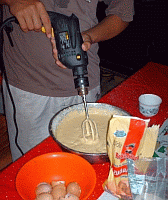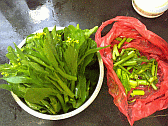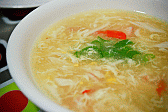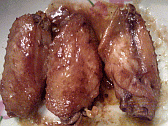|
|
| How
To - Other Produce |
Eggs or
Dan |
|
Eggs are plentiful and quite
diverse in China, as can be witnessed in any wet
market or supermarket. Chicken eggs come in many
forms and some may have been treated in some way.
Some are also used in medical preparations, whilst
others are far better to fry. Let's begin with
standard chicken eggs:
Chicken eggs are called 'gai dan' in Cantonese,
gai meaning chicken, and dan egg. |
|
Chicken eggs are normally sold loose and you
can pick your own. Supermarkets also offer prepacked
egg trays and intimate good quality, although
this is not necessarily so.
When purchasing in a wet market you will find
stalls that only sell eggs, and I mean a massive
range of eggs! Most will have a small weird rack
with light bulbs beneath - these are used to check
the eggs and you are welcome to inspect every
one before buying. The light does show if the
egg is liquid inside, as there is nothing worse
than cooking the rare fertilised one!
Brown Eggs are best for most
English style cooking. Yolks tend to have a good
deep yellow colour because nearly all are free
range. The shells crack with a good sharp blow
and are perfect for frying.
White Eggs are preferred by most
Chinese and are a tad more expensive. Whilst still
free range they come from different chicken species
and have a lighter coloured yolk. Whilst they
are fine I do not use them for cooking as their
shells have a habit of disintegrating when cracked,
with the virtual guarantee the yolk will be punctured
= useless for 'sunny side up'.
Special white eggs cost slightly
more again and come from special chickens. These
are the highest quality, are extremely light beige
in colour, and are supposed to have medicinal
properties. The yolks are a vibrant light yellow.
These can be used as normal, but again I find
their shells cause problems when used for frying.
These eggs are used when making a traditional
Chinese remedy to combat occasional dizziness
or light-headedness. They are cooked for several
hours in a sealed salt vessel and eaten as boiled
eggs (after shelling). The full recipe is given
in our associated medicinal
section
|



|
|
|
Pei Dan or 100-year-old eggs may
be an acquired taste although I really like them. When
made traditionally they are buried in compost and left
in the ground for about 3 months. Nowadays most eggs
are treated commercially to reproduce this effect.
When sold in a wet market they often have a slightly
blue shell colouration similar to the large duck eggs.
If they are not cleaned, then they come covered in what
looks like manure and straw.
They are often used in Cantonese cooking and especially
when preparing 'Sik Juk'
or rice porridge, or tossed with Chinese cress
in a sliced ginger and garlic base using a lot of water.
Recipe: You can try this at home using
cress, lemon cress, or even watercress. Toss a handful
of greens into a wok with a pint of water, add a couple
of ounces of whole garlic and sliced ginger, add a shelled
and broken up pei dan - cook for 3 minutes and serve.
Bantum eggs are from a species of small
chicken called a Bantum. I know these from home on the
farm in England, but they may be new to you? They are
one of the cheapest eggs sold in China, basically because
they are pretty small. They can be white through to
brown, just like the eggs of their larger cousins. Use
as you would any ordinary egg, but reduce cooking times
accordingly. These can be useful for presentation where,
say in a side salad you want to you want to match the
size of cherry tomatoes to that of whole eggs or olives.
Pre-laid eggs. Before we finish
with chicken eggs one Chinese delicacy is to serve eggs
that have not yet been laid. When gutting a chicken
the chef will always keep most of the internals, and
this includes the egg sack - which looks like a string
of yolks attached to a piece of gut and growing smaller
in size.
You can boil these or add to a stew. They take
a few minutes to cook through and are eaten as
is. They taste just like egg yolks - which is
hardly surprising!
Prep chef's also retain the pre-formed eggs found
inside the carcass. One may have a soft shell,
but several will be small eggs with a thin shell.
These can all be cooked in the normal manner and
eaten as usual. Certain vendors at wet markets
will sell these and the yolk sacs, although you
may have to wait or place an order. Normally these
vendors sell live chickens and also offer a plucking
and chopping service. |
 |
|
|
Other Eggs:
Quail Eggs or 'juik dan' are
small mottled yellow / brown as pictured right.
They are common in wet markets and regarded as
a delicacy.
These eggs are normally sold boiled and ready
to eat, but can be bought uncooked.
They are pleasant to eat and almost the same flavour
and texture as hen eggs. |
 |
|
|
Duck Eggs are also quite common in
larger wet markets, especially in country areas where
ducks are reared for market. These eggs are slightly
larger than a standard chicken egg, and just like in
UK have a white or very pale blue shell. Duck eggs do
have a slightly stronger taste, so they are not as popular
as the types above.
Goose Eggs can be ordered or occasionally
bought from local farms that rear geese for market.
These eggs are noticeably larger and have a mild but
distinctive flavour. They are not commonly eaten in
China outside of local communities.
Other Eggs are sometimes available
but tend to be seasonal or associated with the farming
of specialised fowl. These may find their way into a
rural wet market at times but do not count on it. |
|
| This
information is as supplied by ourselves, and ably supported
by our friends and various internet portals. |
|
| Search
this Website |
|
|
| Boy
Cooking |
 |
| Béchamel Related |

|
| Descriptions |





|
| Chinese Recipes |






|
|